In the year that Queen Elizabeth II celebrates her Diamond Jubilee Baldwin’s are delighted to be selling at auction the most British of coin collections. Formed over 34 years by a private collector, the Bentley Collection is the ultimate collection of British gold Sovereigns and is sure to generate interest from collectors and investors alike.
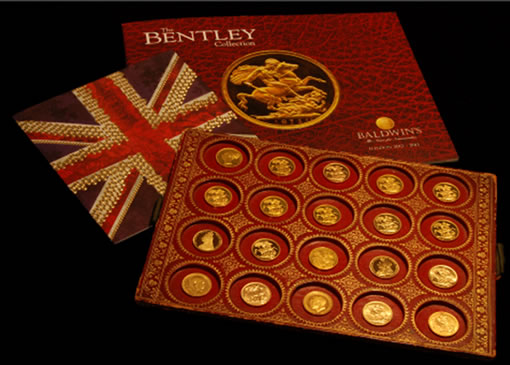
The sale of the first part of this outstanding collection will be held on the 8th May in London and contains over 380 individual lots, all from the Royal Mint when it was based in London. Apart from the extremely rare 1819 Gold Sovereign, part one of the Bentley Collection contains at least one example of every single date issued for currency in the UK, as well as many Pattern and Proof (prototypes of coins) issues. The extremely rare 1819 Sovereign, the finest known specimen in private hands, will be offered for sale in part three of the collection, due to be sold in May 2013.
What began as a foray into the numismatic world as a way of owning gold in the late 1970s quickly became a passionate quest to formulate one of the greatest collections assembled of the British Gold Sovereign. Not only was the collector fascinated by the Sovereigns standpoint in history, as one of the most long-lived, respected and widely distributed coins in the World but, they were also awestruck by the physical form the Sovereign takes, being 22mm in diameter, weighing 7.98g and struck in 22 carat gold. From the start there was a strong focus on acquiring only the highest quality pieces for the collection and a decision to focus on modern currency Sovereign (1817 onwards.)
During the 1990s, in the wake of Black Monday, some major collections were dispersed by private treaty and at public auction, which gave the current owner some fantastic opportunities to acquire some of the most important pieces in the collection. Some of the rarest Pattern and Proof issues were added during this period. As the collection grew it became more than just a complete date of Sovereigns it also became an illustrative history of the modern Sovereign from conception in 1816 until decimalisation under Queen Elizabeth II.
An 1817 George III (1760-1820), Proof Gold Sovereign, 1817, engraved by Benedetto Pistrucci depicts the laureate head of the King and a reverse showing the first incarnation of the now iconic image of St George slaying the dragon with a broken lance.
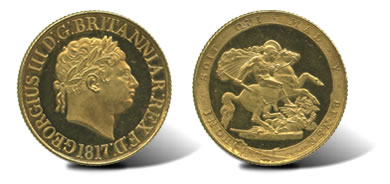
The resulting Sovereign design adopted for currency, here demonstrated struck to "Proof" quality from highly polished dies. Such delightful pieces were gifts given to highly influential persons to show the pride in the new design; today they are extremely rare. The Bentley Collection also contains examples for George III dated 1818 (part three) and 1820 (part two).
This lot is estimated to sell for £15,000 – 20,000. To be offered by Baldwin’s in part one of May 2012 auction of the Bentley Collection of British Gold Sovereigns.
1817 saw the introduction of St George and the dragon by the Italian engraver Benedetto Pistrucci on the reverse of the coin. Pistrucci, originally from Rome, was commissioned by the Master Engraver (William Wellesley Pole) at the Royal Mint to produce designs for the new Gold and Silver coinage of George III.
This portrait of exceptional classical atristry is still used on the reverse today and more recently has been used on all five coins in the Sovereign group. Pistrucci’s involvement with the coinage ceased in 1825, but he continued at the Mint until 1849 as a Master Medallist and was responsible for the equally famous design of the Waterloo medal.
An 1821 George IV (1820-30), Proof Gold Sovereign, 1821, also engraved by Benedetto Pistrucci, depicts St George slaying the dragon right with sword, no helmet streamer, horse’s tail with three terminal strands, broken lance on ground to left.
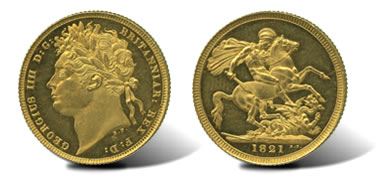
The second incarnation of the St George and dragon reverse design has proven to stand the test of time, and become the most iconic and long-lived depiction of any coin design in the World with little change over the 190 years of issue till 2011. This Proof version from highly polished dies is very rare and highly desirable as the first date this design was issued.
The coin is estimated at £4,000 – £4,500. To be offered by Baldwin’s in part one of May 2012 auction of the Bentley Collection of British Gold Sovereigns.
An 1831 William IV (1831-7), Proof Gold Sovereign is engraved by William Wyon using a model by Francis Chantrey. The reverse is struck with a crowned shield of arms, quartered, with the arms of Hanover as an escutcheon by Jean Baptiste Merlen.
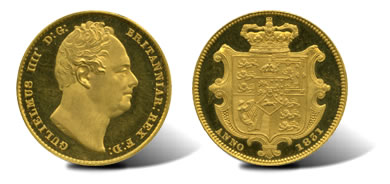
The bust is of the second type showing a slightly different ear profile and the proportion of the bust to the legend is different from that of the first bust type. This second bust type was used in currency from 1832-7. This Proof struck from highly polished dies is very rare, especially in top quality condition, as many were handled or polished as they were part of commemorative proof sets issued in relation to the Coronation of William IV, which took place on the 8th September 1831.
This item is also estimated to achieve £4,000 – 4,500. To be offered by Baldwin’s in part one of May 2012 auction of the Bentley Collection of British Gold Sovereigns.
An 1853 Victoria (1837-1901), Proof Gold Sovereign, 1853, engraved after William Wyon, depicts the second larger young head of Queen left, with double fillet, W.W incuse on truncation. The reverse engraved after Jean Baptiste Merlen depicts the crowned shield of arms within laurel wreath tied with bow below shield.
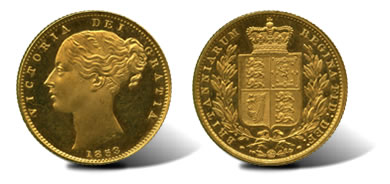
The 1853 Proof Sovereign struck from highly polished dies is a coin that was included in the very rare "proof sets" of all the coinage that were available for purchase from the Court Jeweller "Hunt and Roskell." The coins were available to purchase singly too and are among the rarer Proof Sovereigns of the reign. This particular coin is of superlative quality and very rare.
As a highly desirable coin it carries a healthy estimate of £10,000 – 12,500. To be offered by Baldwin’s in part one of May 2012 auction of the Bentley Collection of British Gold Sovereigns.
An 1825 George IV (1820-30), Proof Gold Sovereign, 1825, engraved by William Wyon after Francis Chantrey’s model. This is a proof of the second type of Sovereign for the reign of George IV. The Bentley Collection contains two varieties of this gold proof, a plain edge version depicted here and the milled edge piece (part two).
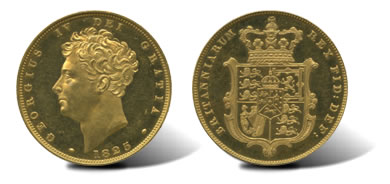
There are also two similar uniface trials struck in "Barton’s Metal" — a copper core with a layer of fine gold over the top, one of the obverse (part two) and one of the reverse (part three), all these proof strikings are very rare.
To be offered by Baldwin’s in part one of May 2012 auction of the Bentley Collection of British Gold Sovereigns.
An 1839 Victoria (1837-1901), Proof Gold Sovereign, 1839, slight ghosting, engraved by William Wyon. This is a proof Sovereign struck from highly polished dies of the currency design with the plain edge.
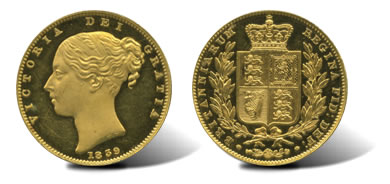
The Bentley Collection specimen is in a superb state of preservation and was the variety issued in the full proof sets to commemorate the new Young head coinage of Queen Victoria.
To be offered by Baldwin’s in part one of May 2012 auction of the Bentley Collection of British Gold Sovereigns.
Rare currency pieces include George IV 1823 and 1828; William IV 1836 with N in the shield; Victorian narrow shields of 1838 and 1843; the 1841 with unbarred As; 1863 die number 22 with 827 on truncation and a selection of extremely rare Queen Elizabeth II proofs and specimens.
The Bentley Collection will be sold in three parts during 2012/13. Bidders are strongly encouraged to attend these landmark auctions where possible, although the sale will be broadcast over the internet using the services of www.the-saleroom.com. Catalogues will be available online at www.baldwin.co.uk and can also be purchased through our website. A hard-bound edition of all three catalogues will be available soon after the final event in May 2013.
About Baldwin’s
Established in 1872 A. H. Baldwin & Sons Ltd has over 100 years experience in servicing the numismatic industry. Although founded much earlier, the name A.H. Baldwin & Sons didn’t become synonymous with the London numismatic scene until 1901 when Albert Henry set up his first London based premises on Duncannon Street with his eldest son Percy, joined later by his two other sons Fred (legendary cataloguer of King Farouk of Egypt’s coin collection) and Roy.
Baldwin’s auction department was established in 1993 and has grown to hold between ten and twelve sales annually in London, New York, Hong Kong and Dubai and specialize in all areas of Numismatics.






These have to be some of the most beautiful coins of their age that I have ever seen. Considering what PCGS calls MS65-70 in coins of that age, these coins would be graded 1000+++. American coins of that age are typically crap and without any style, but graded as 68-70, total joke.